Embark on an extraordinary journey with Vietnam Travel – a captivating adventure through Southeast Asia’s gem. Vietnam, a diverse tapestry of exquisite cuisine, fascinating history, and warm hospitality, awaits exploration. This guide unveils essential insights, from the ideal time to visit to cultural nuances, ensuring an enriching experience in this beautiful destination.
With over 3000 positive reviews on reputable travel channels, Joy Journeys consistently upholds the motto “more than a trip” as the foundation for our tours. These will be the top-rated tours at Joy Journeys, as reviewed by our customers.
Contents
- 1 Vietnam Destinations
- 2 Essential Travel Tips for Vietnam
- 3 Vietnamese Culture and History
- 4 Recommendations for Activities and Attractions
- 5 Navigating Accommodations for Your Vietnam Holiday
- 6 Savoring Vietnamese Cuisine
- 7 A Transportation Guide for Travelers
- 8 Quickly learn common communication phrases in Vietnam
- 9 Conclusion
- 10 Frequently Asked Questions
Vietnam Destinations
Nestled in Southeast Asia, Vietnam beckons travelers with a tapestry woven from its rich history, diverse landscapes, and vibrant cultures.
Overview of Popular Tourist Destinations
Vietnam’s tourist landscape is a canvas painted with natural wonders, ancient history, and the pulse of contemporary life. Each destination holds a distinct charm, contributing to the multifaceted tapestry that defines Vietnam’s appeal.
Highlighting Specific Locations
- Mekong Delta: The Mekong Delta, often referred to as the “Rice Bowl” of Vietnam, unveils a serene landscape of lush greenery and winding waterways. Floating markets, traditional villages, and the rhythmic life along the riverbanks offer an authentic glimpse into Vietnamese agrarian life.
- Cu Chi Tunnels: Delve into Vietnam’s wartime history at the Cu Chi Tunnels, an intricate network that served as a strategic base during the Vietnam War. Gain insights into guerrilla warfare tactics and the resilience of the Vietnamese people as you navigate this underground labyrinth.
- Hanoi: Hanoi, the capital city, exudes an old-world charm with its centuries-old architecture, bustling markets, and the intoxicating aroma of street food. The Old Quarter narrates tales of the city’s imperial past, while the Ho Chi Minh Mausoleum pays homage to the nation’s founding father.
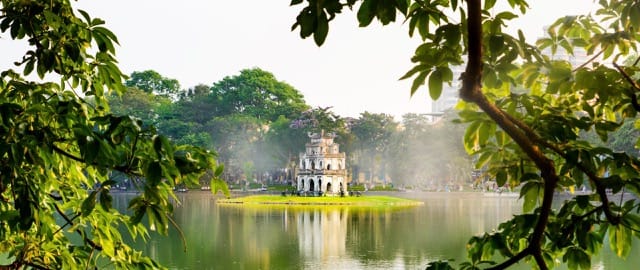
Hoan Kiem Lake – The symbol of Hanoi – Source: Collected
- Ho Chi Minh City: Formerly Saigon, Ho Chi Minh City is a bustling metropolis where modernity intertwines with tradition. Skyscrapers share the skyline with pagodas, and street markets hum with activity. The War Remnants Museum and Notre-Dame Cathedral Basilica offer glimpses into the city’s complex history.

Ho Chi Minh City – Source: Collected - Ha Long Bay: Ha Long Bay, a UNESCO World Heritage Site, is a symphony of limestone karsts and emerald waters. Cruise through this ethereal seascape, discovering hidden caves and floating fishing villages. Ha Long Bay is a testament to Vietnam’s natural beauty and the ingenuity of its people.

Vinh Ha Long – UNESCO Heritage in Vietnam – Source: Collected - Hoi An: Hoi An, a well-preserved ancient town, invites you to stroll through lantern-lit streets, adorned with traditional architecture. This UNESCO-listed gem is renowned for its tailor shops, vibrant markets, and the enchanting beauty of its lantern-lit nights.
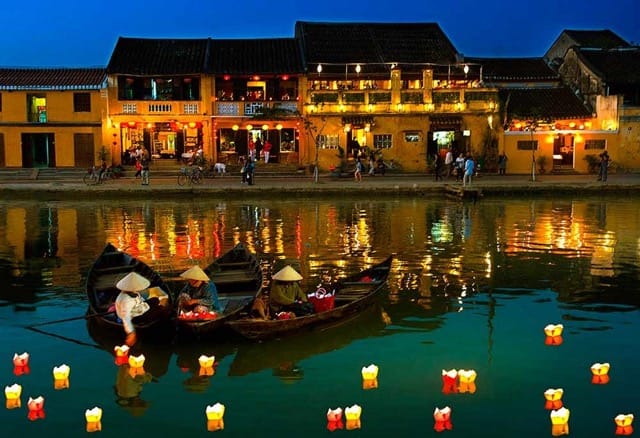
Hoi An – Source: Collected - Ha Giang: Ha Giang, in the northern highlands, captivates with its dramatic landscapes. Towering mountains, terraced rice fields, and ethnic minority communities paint a picture of traditional life untouched by time. The Ma Pi Leng Pass offers breathtaking views of this rugged terrain.

Ha Giang – Source: Collected
Essential Travel Tips for Vietnam
Embarking on a journey to Vietnam is an exploration of vibrant cultures, breathtaking landscapes, and a tapestry of historical richness. To ensure your trip is a seamless and enriching experience, consider these essential travel tips that cover everything from the best time to visit to ensuring your safety in this captivating destination.
The Best Time to Vietnam Travel
The best season to visit Vietnam based on weather patterns and seasonal events should be considered while planning travel.
Vietnam’s climate varies by region, with the southern part having a more tropical warmth and the northern and center regions having distinct seasons.
Typically, September to November and March to May are the best months to travel to northern Vietnam because of the pleasant and dry weather.
When the weather is sunny and dry, February through May is the perfect time to explore Central Vietnam.
Although it is always hot and muggy in Southern Vietnam, November to April is the most fantastic time to go because of the cooler, drier weather.
Seasonal events like the Tet holiday, the biggest and most important holiday in Vietnam, which can disrupt travel and service availability, should also be considered by tourists. This holiday falls in January or February.
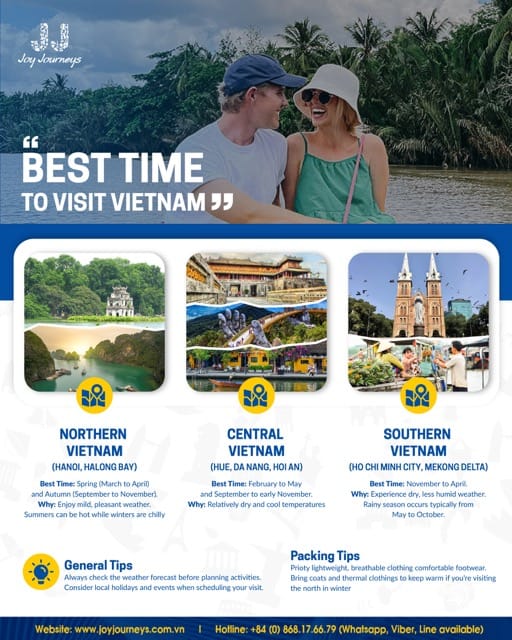
Visa Requirements and Travel Documentation
Navigating Vietnam’s visa requirements is a crucial step in ensuring a smooth entry into this enchanting destination. Here’s a detailed guide to facilitate the process:
Detailed Information on Obtaining a Visa:
- Visa on Arrival (VOA): Many travelers opt for Visa on Arrival, a convenient process that involves obtaining a pre-approved visa letter online. Upon arrival at major airports, complete the visa stamping process. Ensure your passport has at least six months of validity beyond your intended departure date.
- E-Visa: An alternative is the E-Visa, applied for online before your trip. This option is suitable for those arriving by land, air, or sea and is available for a single entry of up to 90 days.
- Embassy/Consulate: Traditionalists may prefer obtaining a visa from the Vietnamese Embassy or Consulate in their home country. Initiate this process well in advance to ensure timely approval.
You can register online here.
Requirements to Travel to Vietnam
- Passport: A valid passport is the primary requirement for entering Vietnam. Ensure your passport has sufficient blank pages for visa stamps and meets the minimum validity criteria.
- Visa Approval Letter: For Visa on Arrival, obtain the visa approval letter from a reputable agency. This letter is essential for obtaining the actual visa stamp upon arrival.
- E-Visa Application: If opting for an E-Visa, complete the online application form, providing accurate and up-to-date information. Check specific requirements for your nationality, as they may vary.
Preparing necessary documents before the trip
For citizens of more than 80 nations, including the United States, Canada, the United Kingdom, and Australia, Vietnam offers an online e – visa program.
The e-visa is valid for up to 90 days and permits one entry or multiple entries into Vietnam for transit, business, or tourist.
Visitors must submit an online application form, a passport-style photo, a scanned copy of their passport’s biographical page, and payment for the visa to apply for an e-visa.
The e-visa will be sent to the applicant’s email address when the application has been processed, which generally takes three to five working days.
It’s essential to remember that not all Vietnamese entrance points accept e-visas, so prospective travelers should check the list of approved ports of entry before applying.
Also, visitors must comply with Vietnamese immigration laws while in the country and possess a valid passport for at least six months from the entrance date.
Understanding the visa process and meeting all requirements ensures a smooth entry into Vietnam, setting the stage for a stress-free exploration of the country’s wonders.
Currency Information and Money Tips
Currency conversion is one of the most crucial pre-trip considerations you should be aware of while visiting Vietnam. The Vietnamese dong (abbreviated as “VND”) is the country’s official unit of exchange.
Only paper denominations of the dong are currently offered, while coins have been eliminated; the paper notes of the Vietnamese dong are currently available in the following denominations:
- 1,000 VND ~ 0.04 USD
- 2,000 Dong ~ 0.08 USD
- 5,000 Dong ~ 0.21 USD
- 10,000 Dong ~ 0.42 USD
- 20,000 Dong ~ 0.82 USD
- 50,000 Dong ~ 2.05 USD
- 100,000 Dong ~ 4.1 USD
- 200,000 Dong ~ 8.2 USD
- 500,000 Dong ~ 20.5 USD
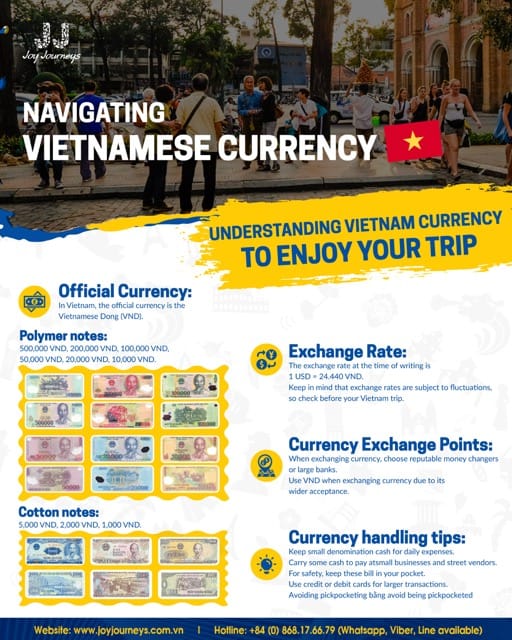
The Vietnamese dong is now exchanged at around 24,345 VND to the US dollar (USD) as of January 2024. For instance, a 50,000 VND cup of coffee will cost you around 2 USD.
Foreign currencies like the Euro, British pound, or Australian dollar fluctuate based on market rates.
To ensure fair exchange rates and prevent fraud, exchanging money at reputable banks or exchange counters in Vietnam is suggested.
Credit cards are readily accepted at popular tourist destinations and large cities, but carrying cash for minor purchases and transactions is still a good idea.
Authorized banks, exchange booths, and hotels offer currency exchange services in major towns and popular tourist destinations around Vietnam. Below are some popular locations in Vietnam for currency exchange.
- Banks: Banks provide competitively priced, safe, and trustworthy currency exchange services. Vietcombank, BIDV, and VietinBank are a few of the largest banks in Vietnam. To ensure a fair exchange rate, it is advised to exchange currency in a bank during business hours.
- Exchange booths: These are more practical options for exchanging currency and are typically found in tourist hotspots. But, it’s vital to exercise caution when dealing with exchange booths that advertise rates that seem too good to be true because they might be engaged in fraud or scams.
- Hotels: Several hotels provide their customers with currency exchange services, but the exchange rates might not be as favorable as those at banks or exchange booths.
- Airports: Vietnam’s airports offer currency exchange services, albeit the conversion rates might be better than those offered by banks or exchange booths.
Most Vietnamese cities and popular tourist destinations accept credit cards and ATMs widely.
However, having cash for smaller purchases and transactions is essential because certain businesses may only take cash payments in Vietnamese dong.
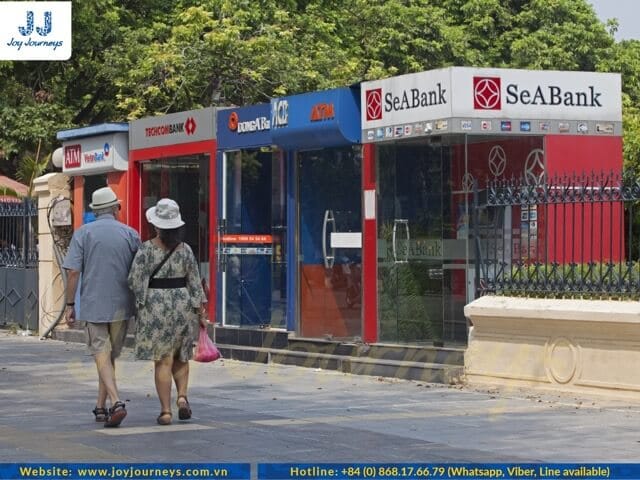
Vietnam Travel Safety Tips
Ensuring your safety is paramount for an enjoyable trip. Vietnam is generally considered safe for travelers, but adopting these safety tips enhances your overall experience:
- Public Transportation Awareness: Exercise caution when using public transportation. Use reputable services, and be wary of unmarked taxis. Arrange motorbike taxis, known as “xe om,” through reliable sources.
- Health Precautions: Prioritize your health by drinking bottled or purified water, especially in remote areas. Apply mosquito repellent in regions prone to diseases like dengue fever. Ensure your vaccinations, including hepatitis A and B, are up to date.
- Traffic Vigilance: Traffic in Vietnam can be chaotic, especially in urban areas. Exercise caution when crossing the street, as traffic may not adhere to traditional rules. Use pedestrian crossings when available and observe local practices.
- Valuables and Personal Belongings: Keep your belongings secure, especially in crowded areas. Use a money belt or secure pouch for important documents and valuables. Be vigilant against pickpocketing, especially in crowded markets.
- Local Customs and Respect: Respect local customs and traditions. Modesty is appreciated, especially when visiting temples and religious sites. Ask for permission before taking photos of individuals, particularly in ethnic minority villages.
- Emergency Contacts and Local Assistance: Save important contacts, including local emergency numbers and the contact information of your embassy or consulate. Familiarize yourself with the nearest medical facilities.

Things to know for a fantastic trip of a lifetime
Following a temporary shutdown due to the COVID-19 epidemic, Vietnam’s borders for international tourists were formally reopened on March 15th, 2022.
Since then, limits and admission procedures have been in place to guarantee the security of both tourists and locals.
Depending on the COVID-19 scenario and governmental policy, these requirements could alter.
Below is further information about Vietnam’s current admission requirements in more detail:
Vaccination: As of May 2022, a Covid-19 vaccination passport is not required for international travelers visiting Vietnam. The requirement for quarantine upon entry is also not applied to foreign tourists. However, reviewing the most recent data offered by your country’s Vietnamese embassy or consulate is recommended.
Covid testing & Health declaration: The requirement for COVID-19 testing before entry into Vietnam was temporarily ceased beginning on May 15th, 2022.
This decision was made considering the pandemic’s current situation, which has seen a marked decline in the number of cases in Vietnam. Therefore, travelers can be worry-free about the pandemic while visiting Vietnam.
Covid insurance: There is no covid insurance required when entering Vietnam as of the present time.
It is crucial to remember that additional precautions, including health declarations, mask use, and social distancing, are still required for travelers entering Vietnam.
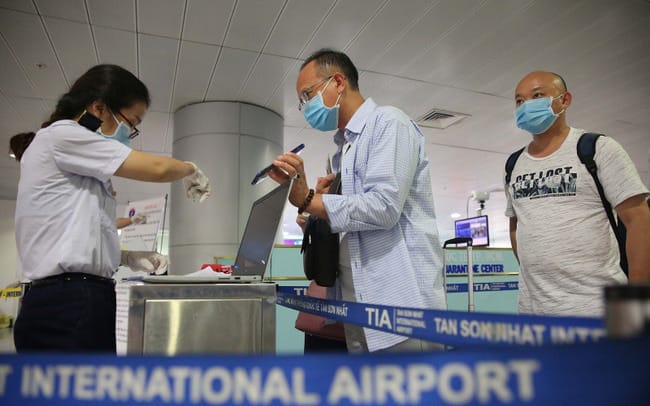
Vietnamese Culture and History
Vietnam’s fantastic culture that you should know
International travelers visiting Vietnam should be aware of some behaviors and customs to respect Vietnamese culture and traditions because the country has a rich and diversified cultural history. These are a few circumstances:
- Greetings: The traditional way to welcome someone in Vietnamese culture is with a bow or a head nod. Although handshakes are becoming increasingly popular, it is best to take the other person’s cues when giving a greeting. When introducing yourself, it’s customary to do a slight bow and say “xin chao” (pronounce it “sin jow”), which is Vietnamese for “hello.”
- Family-Centric Values: Central to Vietnamese culture is the paramount importance of family. The extended family plays a pivotal role, and familial bonds are cherished. Respect for ancestors is ingrained, with ancestral altars a common sight in homes, symbolizing a connection between past and present.
- Dress: Modest attire is advised while visiting religious places or attending formal occasions. It’s also essential to take your shoes off before entering places of worship or private residences. Vietnam may get quite warm and muggy, especially in the summer. To stay relaxed and comfortable, choose lightweight and breathable clothing, cotton or linen. Due to its tropical environment, Vietnam is susceptible to sporadic downpours all year. To remain dry, bring a small umbrella or raincoat.
- Dining: In Vietnam, chopsticks are typically used with a spoon while eating soups and rice. Sharing meals as a family is also traditional. Frequently, multiple dishes are ordered and placed in the middle of the table. Each person then takes a small amount of each word. When drinking alcohol with others, it is common to utter the phrase “mot, hai, ba, yo!” (which translates to “one, two, three, cheers!”). Vietnamese dining customs place a strong emphasis on sharing and respect for others. You should show respect for the community and have a nice lunch by adhering to these traditions.
- Respect for elders: In Vietnamese, “cam on” is the word for “thank you” (pronounced “kahm uhn”). To express thanks and respect, use this phrase frequently. The Vietnamese culture places a high priority on respect for elders. Use the appropriate honorifics to convey respect when conversing with those who are older than you (such as “anh” for older brother or “ba” for grandmother).
- Gift-giving: It’s common to deliver a little gift, such as fruit or flowers when visiting someone’s home in Vietnam. Giving too expensive gifts can make the recipient uneasy; therefore, avoid doing so.
Vietnamese customs concentrate heavily on respect for others and a readiness to be hospitable.
You may respect the local way of life and get the most out of your trip to Vietnam by sticking to these customs.
Historical Background and Traditions
Vietnam’s history is a riveting saga of resilience and determination, marked by periods of imperial rule, foreign invasions, and a relentless pursuit of independence. The legacy of this tumultuous past is imprinted on the nation’s architecture, literature, and societal norms.
- Dynastic Eras and Imperial Legacy: Vietnam’s dynastic eras, notably the Ly, Tran, and Nguyen dynasties, have left an indelible mark on the country’s cultural and architectural landscape. The Imperial City of Hue stands as a testament to the grandeur of Vietnamese emperors.
- The Vietnam War: The Vietnam War, a pivotal chapter in the nation’s history, has left an enduring impact. Sites like the Cu Chi Tunnels near Ho Chi Minh City bear witness to the ingenuity of Vietnamese resistance against external forces.
Insight into Festivals and Cultural Events
- Vietnamese Culture: Vietnamese culture thrives in its festivals, where traditions come alive with vibrant celebrations. Tet, the Lunar New Year, stands as the most significant festival, marked by family reunions, traditional rituals, and the iconic dragon and lion dances.
- Vietnam Festivals: Vietnam’s festivals are a kaleidoscope of colors, rituals, and communal spirit. The Mid-Autumn Festival, celebrating the harvest moon, is a joyous occasion with lantern processions and delectable mooncakes. The Hue Festival, a biennial event, showcases the city’s cultural heritage through traditional music, dance, and historical reenactments.
Recommendations for Activities and Attractions
Outdoor Adventures
Vietnam’s diverse landscapes offer a playground for outdoor enthusiasts. Whether trekking in the misty mountains of Sapa, kayaking through the limestone karsts of Ha Long Bay, or exploring the scenic beauty of Phong Nha-Ke Bang National Park, outdoor adventures in Vietnam are a symphony of natural wonders.
The dramatic scenery of terraced rice fields in Mu Cang Chai and the adrenaline rush of motorbike journeys through the winding roads of the Hai Van Pass provide a feast for the senses.
Cultural Experiences
Immerse yourself in the cultural tapestry of Vietnam by partaking in authentic experiences. Attend a water puppet show in Hanoi, a traditional art form dating back centuries. Explore the bustling markets of Hoi An, where the air is filled with the aromas of local delicacies and vibrant textiles. Engage with ethnic minority communities in the northern highlands for a glimpse into their centuries-old traditions. Vietnamese cooking classes, where you can master the art of crafting iconic dishes like pho and spring rolls, offer a hands-on connection to the country’s culinary heritage.
Specific Attractions in Major Cities
- Mekong Delta: Explore the intricate waterways of the Mekong Delta, a verdant region teeming with life. Navigate the floating markets, visit traditional villages, and witness the vibrant tapestry of local life. The Cai Rang Floating Market, a highlight of the Mekong Delta, immerses you in a lively spectacle of boats laden with fresh produce and local goods. This unique market experience offers a glimpse into the daily life of the Mekong Delta residents.
- Hanoi: The capital city, Hanoi, unfolds its history through captivating museums and landmarks. The Ho Chi Minh Mausoleum, dedicated to the revered leader, offers a solemn experience. The Vietnam Museum of Ethnology provides insights into the country’s diverse ethnic groups. Explore the Old Quarter, a labyrinthine network of narrow streets bursting with history and street vendors.
- Ho Chi Minh City: Formerly Saigon, Ho Chi Minh City dazzles with its modernity juxtaposed against historical gems. The War Remnants Museum chronicles Vietnam’s tumultuous past, while the Notre-Dame Cathedral Basilica of Saigon stands as a testament to French colonial influence. Dive into the bustling atmosphere of Ben Thanh Market for a sensory overload of sights, sounds, and tastes.
- Hoi An: A UNESCO World Heritage site, Hoi An enchants with its well-preserved ancient town. Wander through the charming streets adorned with lanterns, explore traditional houses like the Tan Ky House, and savor local delicacies. The Japanese Covered Bridge, a symbol of Hoi An, beckons with its architectural grace.
- Hue: The former imperial capital, Hue, boasts the majestic Imperial City, a vast complex of palaces, temples, and gates. The Perfume River, with its dragon boats, offers a tranquil cruise. Visit the Thien Mu Pagoda, an iconic symbol overlooking the river.
- Da Nang: Da Nang captivates with its modernity and scenic beauty. The Marble Mountains, with their caves and pagodas, provide panoramic views. The Dragon Bridge comes alive with lights and fire on weekends. My Khe Beach offers a relaxing retreat.
Engaging Activities for a Fulfilling Travel Experience
- Homestays in Rural Villages: For a deeper connection to Vietnamese culture, consider a homestay in rural villages, including those in the Mekong Delta. Experience daily life, participate in traditional activities, and forge meaningful connections with locals. This immersive experience offers a unique perspective on the authenticity of Vietnamese hospitality.
- Waterway Explorations in the Mekong Delta: Navigate the intricate network of waterways in the Mekong Delta. Floating markets, traditional villages, and lush landscapes create a serene backdrop. Mekong Delta boat tours provide an intimate encounter with the rhythm of life along the river.
- Scenic Train Journeys: Embark on a scenic train journey to witness Vietnam’s landscapes unfold. The Reunification Express, traversing from Hanoi to Ho Chi Minh City, offers breathtaking views of the countryside, mountains, and coastal stretches.
- Beach Retreats in Phu Quoc: For a tranquil escape, the island of Phu Quoc, located off the Mekong Delta, beckons with pristine beaches and turquoise waters. Enjoy water activities, indulge in fresh seafood, and relish the serenity of this tropical paradise.
Overview of Accommodation Options
When embarking on a journey through Vietnam, the diversity of accommodation options ensures that every traveler finds a comfortable haven. From luxurious hotels to cozy guesthouses and unique stays, the spectrum caters to varied preferences and budgets.
- Hotels: Vietnam boasts a wide array of hotels, ranging from opulent five-star establishments to boutique gems. Major cities like Hanoi, Ho Chi Minh City, and Da Nang showcase a skyline adorned with internationally renowned hotel chains, offering a blend of modern comforts and Vietnamese hospitality.
- Guesthouses: For a more intimate experience, guesthouses dot the landscape, especially in smaller towns and rural areas. These provide a chance to immerse yourself in local charm, with personalized service and a glimpse into authentic Vietnamese lifestyles.
- Unique Stays:Venture beyond conventional options with unique stays that redefine accommodation experiences. Homestays in ethnic minority villages, eco-friendly lodges in natural reserves, and floating hotels in Ha Long Bay offer a distinctive connection to Vietnam’s diverse landscapes.
Highlighting Different Regions and Their Offerings
- Northern Vietnam: In Hanoi, the capital, choose from a range of accommodations nestled in the Old Quarter’s historic charm or opt for modern comforts in the French Quarter. In Sapa, mountain lodges provide a cozy retreat amid terraced landscapes.
- Central Vietnam: Hoi An enchants with its ancient town, offering boutique hotels and charming guesthouses. Da Nang, a coastal city, provides a mix of beachfront resorts and urban retreats, while Hue boasts riverside accommodations near its historic landmarks.
- Southern Vietnam: Ho Chi Minh City dazzles with luxury hotels in its bustling districts. The Mekong Delta offers unique homestays, providing an immersive experience in the delta’s rustic beauty.
Tips for Choosing the Right Accommodation
Planning the perfect Vietnam holiday involves strategic accommodation choices. Consider these tips to ensure a seamless stay:
- Define Your Preferences: Before diving into options, outline your preferences. Are you seeking cultural immersion, luxury indulgence, or proximity to natural wonders? Understanding your priorities streamlines the decision-making process.
- Research Regions and Seasons: Vietnam’s regions vary in climate and attractions. Whether it’s the misty mountains of the north, the historic towns of the central region, or the vibrant energy of the south, align your accommodation with the experiences each region offers.
- Budget Wisely: Establish a budget range for accommodation, keeping in mind that Vietnam offers choices for every wallet size. Balance your desire for comfort with the overall budget for a more enjoyable holiday experience.
- Read Reviews and Recommendations: Leverage online platforms for reviews and recommendations from fellow travelers. Insights from those who have experienced the accommodations firsthand provide valuable perspectives.
- Consider Unique Stays for a Memorable Experience: Elevate your holiday by opting for unique stays. Whether it’s a traditional homestay, a boutique villa, or a resort blending seamlessly with nature, these choices add an extra layer of authenticity to your Vietnam experience.
- Prioritize Location: Evaluate the proximity of your accommodation to key attractions, public transportation, and local amenities. A strategic location enhances the efficiency of your exploration.
- Check Amenities and Services: Different accommodations offer various amenities and services. Assess your needs—whether it’s Wi-Fi connectivity, wellness facilities, or guided tours—and choose accordingly.
- Book in Advance: Especially during peak seasons, booking in advance secures your preferred accommodation and often provides better rates. It ensures a stress-free arrival, allowing you to focus on the pleasures of your holiday.
Savoring Vietnamese Cuisine
Vietnamese cuisine, a symphony of flavors and aromas, stands as a testament to the nation’s rich culinary heritage. Rooted in a harmonious blend of indigenous ingredients and centuries-old influences, Vietnamese dishes are a gastronomic journey that captivates the palate.
Must-Try Dishes and Street Food
- Pho: No exploration of Vietnamese cuisine is complete without indulging in a steaming bowl of Pho. This iconic noodle soup, featuring broth infused with spices, rice noodles, and tender slices of beef or chicken, epitomizes comfort and complexity in a single spoonful. Whether sampled in the frenetic streets of Hanoi or a local neighborhood eatery, Pho transcends its humble origins to become a global culinary sensation.
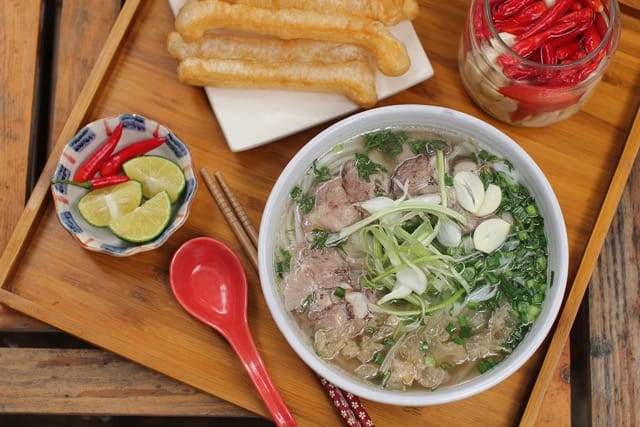
Beef Pho – Source: Collected - Banh Mi: A product of French-Vietnamese fusion, Banh Mi is a delectable sandwich that reflects Vietnam’s historical tapestry. Crispy baguettes cradle a medley of ingredients, from savory meats like pork or chicken to fresh herbs, pickled vegetables, and piquant sauces. Each bite is a burst of contrasting textures and flavors, creating a street food marvel celebrated worldwide.
- Bun Cha: Hailing from Hanoi, Bun Cha is a harmonious combination of grilled pork patties, vermicelli noodles, and a dipping sauce that embodies the delicate balance of sweet, savory, and umami. Often accompanied by fresh herbs and crunchy spring rolls, Bun Cha exemplifies the artistry of Vietnamese noodle dishes.
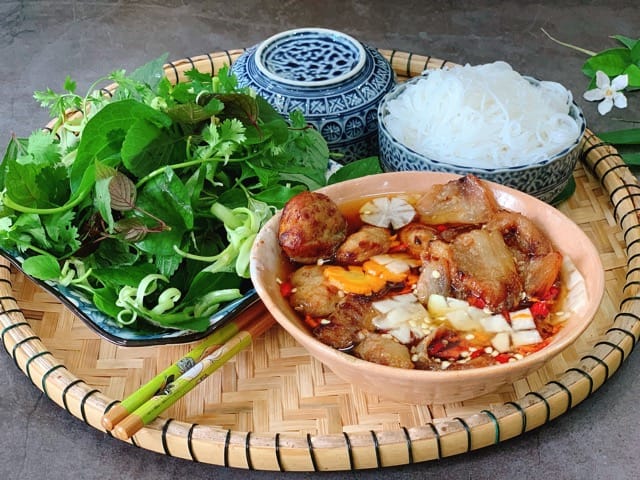
Vietnamese Bún Chả – Source: Collected - Goi Cuon: Goi Cuon, or fresh spring rolls, exemplify the Vietnamese commitment to freshness. Translucent rice paper encases a medley of shrimp, herbs, pork, and vermicelli, creating a light and refreshing delicacy. Dipped in a tangy peanut sauce, these rolls are a quintessential appetizer that captures the essence of Vietnamese dining.
- Com Tam: A dish born from southern Vietnam, Com Tam, or broken rice, showcases the resourcefulness of Vietnamese cuisine. Com Tam features broken rice grains, often accompanied by grilled pork, fried egg, and a medley of pickled vegetables. This humble dish, once considered a frugal option, has evolved into a beloved comfort food.
Cultural Significance of Vietnamese Food
Vietnamese cuisine extends beyond mere sustenance; it is a cultural phenomenon deeply embedded in the nation’s identity. The art of Vietnamese cooking is a reflection of historical influences, agricultural abundance, and a profound connection to nature.
- Communal Dining and Social Bonds: Meals in Vietnam are not just about sustenance; they are a celebration of communal bonds. Traditional Vietnamese dining often involves shared dishes, encouraging a sense of togetherness and fostering connections. The act of sharing a meal transcends the culinary experience, embodying the warmth and hospitality ingrained in Vietnamese culture.
- Harmony in Ingredients and Flavors: Vietnamese cuisine is characterized by a meticulous balance of flavors—sweetness, saltiness, sourness, bitterness, and umami. This harmony reflects the Confucian philosophy of balance, resonating not only in the culinary arts but also in the broader aspects of Vietnamese life.
- Freshness and Connection to Nature: Freshness is the cornerstone of Vietnamese cuisine, with an emphasis on locally sourced, seasonal ingredients. The vibrant markets teem with colorful produce, herbs, and spices, creating a visual feast that mirrors the country’s agricultural abundance. This connection to nature is not just culinary; it is a cultural ethos that honors the land and its offerings.
A Transportation Guide for Travelers
From traditional cyclos to modern ride-sharing services, making informed choices is the key to a seamless exploration of this captivating nation. This guide aims to demystify Vietnam’s transportation network, offering valuable insights for a rewarding travel experience.
Exploring Public Vietnam Transportation Options
- Vietnam Train: For traversing longer distances, the Vietnam train system unfolds picturesque views of the countryside and bustling cities. With classes ranging from budget to luxury, trains are a safe and convenient mode of public transportation in Vietnam. Fares depend on distance and class, available at train stations, ticket-selling points, and online.
- Vietnam Bus: Extensive bus routes cover major cities and popular destinations, offering an affordable mode of transport. While prices are reasonable, buses can become crowded during peak hours. Tickets are available on buses or at ticket-selling points near major stops, with detailed information on websites or mobile apps of local transportation companies.
- Vietnam Taxi: Taxis, abundant in major cities, offer convenience and come in various types. Most services charge based on metered distance, and ride-hailing apps like Grab enhance accessibility. Negotiating fares in advance is advisable, with vigilant considerations for potential issues such as higher prices or meter discrepancies.
- Motorbike Rental: Renting a motorbike in Vietnam provides a sense of adventure and flexibility. Prices range from 100,000 to 250,000 Vietnamese dong per day, with three main bike types available: scooters, manual/semi-automatic bikes, and manual clutch bikes. Prioritizing safety, wearing helmets, possessing a valid license, and adhering to traffic rules are imperative for a secure and memorable motorbike journey.
Other Transportation in Vietnam
- Ride-Hailing Services: While Uber has exited the market, Grab continues to thrive, offering efficient and cost-effective transportation solutions. These apps, accessible with a few taps, provide various vehicle options, expanded access to remote locations, and enhanced safety features. Users should prioritize safety by verifying driver information before rides and familiarizing themselves with app policies.
- Cycling in Vietnam: Cycling emerges as an enjoyable and eco-friendly means to explore Vietnam’s natural beauty and culture. Diverse cycling routes cater to different preferences, from coastal rides to exploring iconic regions like Hoi An and Sapa. Prioritizing safety, wearing helmets, and carrying essentials ensure a pleasant cycling experience.
- Cyclo Vietnamese: A cyclo ride offers a unique cultural journey, allowing travelers to leisurely explore urban areas and immerse themselves in local life. Negotiating fares with drivers beforehand is customary, and ensuring the security of belongings during the ride is essential for a memorable experience.
- Vietnam’s Airports: Vietnam boasts several domestic and international airports, serving as gateways to various regions. Notable airports include Noi Bai International Airport in Hanoi, Tan Son Nhat International Airport in Ho Chi Minh City, Da Nang International Airport, and Cam Ranh International Airport. Travelers should choose transportation options to airports based on cost, convenience, and comfort.
Quickly learn common communication phrases in Vietnam
Since Vietnamese is the national language and is not widely known outside of Vietnam, travelers may experience communication difficulties. The following practical advice can help you enjoy your trip more.
Although English is a common language in tourist regions and is taught in schools, not all residents are fluent English speakers.
Learning some essential Vietnamese words and phrases and traveling with a phrasebook or translation app is a good idea to facilitate conversation.
Vietnamese uses tonal inflection to distinguish between words, making pronunciation challenging for non-native speakers.
It’s critical to pay close attention and request clarification if necessary.
Nonverbal communication techniques like hand gestures and facial expressions can convey meaning when there are language problems.
It’s crucial to pay attention to nonverbal clues and respect social mores and customs in the area.
Hiring a local translator or tour guide can be good to overcome language problems and gain a more comprehensive grasp of Vietnamese culture and history. It’s critical to remember that because Vietnamese is a tonal language, each word’s meaning might vary depending on the tone and inflection used.
Communication can be improved, and rapport can be developed with locals by practicing with a native speaker and respecting local customs.
Learning common Vietnamese words and phrases before visiting Vietnam can help me converse with locals.
Some frequent expressions include:
“Xin chao” for hello, “Cám ơn” for thank you, “Vâng” for yes, and “Không” for no. To apologize or get someone’s attention, you can use “Xin lỗi.” For saying goodbye, “Tạm biệt” is commonly used. To ask how someone is, you can ask, “Bạn khỏe không?” And if you don’t understand something, you can say “Tôi không hiểu.” To ask for help, you can say “Bạn có thể giúp tôi được không?” And to ask for the price, you can say, “Bao nhiêu tiền?”
Conclusion
Prepare for a seamless Vietnam adventure by understanding visa requirements, customs, and language basics. Whether wandering historic cities, lounging on pristine beaches, or trekking lush mountains, diverse experiences await.
Embrace Vietnam with confidence and an open mind, armed with the insights from this guide. Your journey is not just a trip; it’s an immersion into a tapestry of traditions and landscapes. May your time in Vietnam be filled with enriching moments and unforgettable experiences. Safe travels!
Frequently Asked Questions
Is Vietnam Safe to Travel?
Vietnam is generally safe for tourists. Exercise usual precautions, be aware of your surroundings, and follow local guidelines. While petty crime exists, violent incidents are rare. Stay vigilant in crowded areas, safeguard valuables, and use reliable transportation.
Do I Need a Visa to Travel to Vietnam?
Yes, most travelers need a visa. Check Vietnam’s visa policy, which varies by nationality. Obtain a visa before arrival, often through an embassy or online application. Ensure your passport has sufficient validity, and comply with entry requirements for a smooth journey.
When Is Best to Travel to Vietnam?
The ideal time depends on regions. For the north, visit from September to November or March to May for pleasant weather. Central Vietnam is best from February to May. Southern Vietnam is enjoyable year-round, with November to April offering cooler temperatures.
Is Vietnam Safe for Solo Female Travelers?
Vietnam is generally safe for solo female travelers. Exercise standard precautions, dress modestly to respect local customs, and be cautious in secluded areas at night. Join group tours for added security and connect with fellow travelers for a more enriching experience.


Related Posts
Saigon’s “Flower Market Replica”: Where To Find Them
Ho Chi Minh City’s floral charm is not limited to its bustling wholesale markets. Imagine wandering through a place where vibrant petals, fragrant blooms, and the spirit of traditional Vietnamese markets come alive—without the overwhelming crowds. A flower market replica captures that magic, blending the beauty of fresh flowers with the charm of a curated, […]
Is it Safe to Travel to Vietnam Right Now? A Complete 2025 Guide
Vietnam has emerged as one of Southeast Asia’s most captivating destinations, drawing millions of visitors annually with its rich culture, stunning landscapes, and incredible cuisine. However, many travelers still ask: Is it safe to travel to Vietnam right now? This comprehensive guide provides you with everything you need to know about Vietnam travel safety in […]
Ho Chi Minh Cu Chi Tunnels Tour: The Ultimate Guide
The Cu Chi Tunnels stand as one of Vietnam’s most remarkable historical sites, offering visitors a profound glimpse into the ingenuity and resilience displayed during the Vietnam War. For travelers, a Ho Chi Minh Cu Chi tunnels tour represents an essential experience that combines education, adventure, and deep cultural understanding. This comprehensive guide will help […]